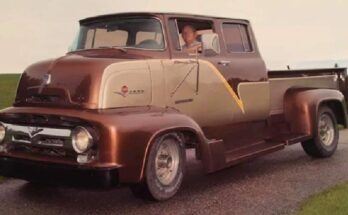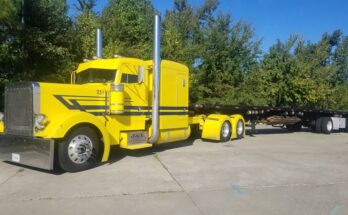Here’s the streets of Victoria, BC, on December 4. We captured this footage from the 15th floor of a downtown apartment.
The video has 3 parts, so you don’t have to watch them all at once. There’s a wide range of trucks, and a wide range of light displays.
In the photos, there’s also a gallery of images of some of the trucks that participated.
The event is the 2016 IEOA Truck Light Convoy and Food Drive.
Subscribe to our YouTube channel (click here).
This truck is in the Pink
The first thing you notice is the color: Not exactly dull gray. Try bright pink. For a truck? And yellow, too.
Why not?
“There should be zero debate on this if this is blue and black or white and gold. The truck and trailer combo is a bright pink and yellow, and the vehicle description states that it’s probably the most unique and most interesting (vehicle) you have ever seen.”
“And we completely agree.”
So says a site in 2015 called “Weird Stuff Wednesday” about one of the vehicles found at Carsforsale.com.
It’s really a modified 1948 Chevrolet 3800 COE. At the time, it was for sale in Calabasas, CA.
“The trailer is about 44 feet long and has not only room for you and your family to sleep in while traveling the country, but the rear has enough room to haul a vehicle or any motorsports equipment,” Weird Stuff says of it.
Its color will certainly attract families. It has room for seven.
Other details:
—It should be easy to shift for even younger members of a family since the transmission was described as automatic.
—Steering, too, should be easy for everyone. It has power steering.
—A tilt wheel,
—Power windows, too.
—Described as having “premium” when it comes to paint and interiors.
—Wheels are also described as premium.
—The condition at the time was described as “excellent.”
—Mileage was 66,618.
The color was described as multi, but pink and yellow might be more accurate.
Other features include:
—A 10-cylinder 502 cubic inch engine.
—A satellite dish.
—Sleeps six in the trailer.
—Freezer and refrigerator.
—A large shower.
—Air conditioning.
—Even the sleeper car has air conditioning.
Background includes this:
Chevrolet trucks from 1947 to 1055 were number one in sales in the US.
They used the same basic design family for all of its trucks, including the Suburban, panel trucks, canopy express and cab overs, according to several accounts.
The “unique Cab Over” fenders and hood required a custom cowl area,” said one description.
“Fully loaded with all the features that make traveling fun…
You and all your friends could have a perfect trip,” says another description of the pink and yellow modified truck.
Another site says of it:
“Spring break is right around the corner and this custom classic with matching trailer is just begging to be taken on a road trip.”
The advertised price was $76,500.
Another popular 1948 3100 Chevrolet truck was the Thriftmaster. Where color was also a consideration.
“Coated in new bright red paint, this 1948 3100 retains its utilitarian good looks and features added touches that make it a hot rod in farmer’s overalls,” it’s said of the truck.
The model recently for sale was equally bright with brisk red paint.
It was described as having a “great looking grille that appears to be original, traditional round headlights trimmed in chrome, and a new, curved chrome bumper.”
The sea of red color is broken up by a left fender mounted filler cap.
The truck’s description goes on:
“Raise the hood on this ’48 Chevy truck and in place of its original Thriftmaster 235 inline six-cylinder you’ll find a completely natural looking small block Chevrolet 350. At the top of the motor, a polished Demon carburetor wears a small round chrome air cleaner, is fed by stainless fuel lines and feeds a Holley Procharger supercharger.”
That bright red color here stands out as much as the pink.
Inside the truck, a restored interior mixes modern elements with traditional 40s design.
“The bright red from the body is present on the dash and contrasts well with gray seats, gray upper door panels, a gray headliner and a gray floorboard,” the description says.
The seats and steering wheel were taken from a 90s Chevrolet and are much easier to live with than the trucks’ original flat bench and huge, thin-rimmed wheel, it adds.
Safety is also a consideration.
For better visibility, Beede gauges have been installed in the classic red dash and display a speedometer and readouts for the engine’s vital readings.
“This 1948 Chevrolet 3100 is a highly drivable truck that follows a simple but proven formula. Take classic good looks and mix a lot of power with nice modern conveniences to get one extremely fun vehicle that can be enjoyed as it was meant to be enjoyed,” the description says.
By David Wilkening
The First RVs
Click here to return to Part I of this article
Since hotels were expensive in those days and towns were friendlier to traveling salesmen and unaccustomed to families, RVers began modifying campers to sleep in them. And cook their meals.
Companies began adding equipment to make them more comfortable like stoves and beds.
Henry Ford, inventor of the Model T, was among people who helped popularize campers in the early years.
A major difference was that many celebrity campers in those early days stayed overnight in tents.
The next move was perhaps predictable.
Auto campers started heading for Florida in the winter.
So-called “Tin Can Tourists” became popular in the 1930s,
For a while, anyone associated with the industry got the “tin can” designation.
We know that camping began to catch on in the 1920s when The New York Times reported that about half of the 11 million vehicles on the road were used for camping.
Campgrounds designed for tourists began in the 1920s. Some of them came with amenities such as golf courses. And even electricity.
The US depression that started in 1929 helped the industry in a sad way: some people who lost their homes moved into campers.
That helped create a boom in sales.
In 1936, the New York Times estimated there were 100,000 trailers on the road. “A new industry is rapidly coming to the front,” the paper said.
One of those manufacturers was the Covered Wagon Company in Michigan. It was the first to build trailers on a large scale.
Naturally enough, they started using the same production techniques of the automobile industry. Its founder, Arthur Sherman, has been called The Father of the RV Industry.
And Elkhart? It began emerging as the center in 1933, according to Hesselbart. That was when the Chicago World Exposition first featured a trailer industry exhibit. That so impressed some Indiana state residents that they began making RVs.
Soon, there were 300 manufacturers within a few miles of the city. Elkhart was being called “The Trailer Capital of the World.”
But not just there.
In Southern California, Wally Byam founded Airstream in the 1930s. He began by building his own trailer and selling the plans for $1 each through Popular Mechanics magazine.
There were other companies like it, but Airstream’s streamlined metal design outlasted most of them.
Another familiar name in the industry, Winnebago Industries, started production from a former trailer factory in 1958. They began selling for as little as $5,000 from the Forest City, Iowa factory.
Another famous company, Fleetwood Enterprises was created in the 1950s. Founder John Crean is given credit for introducing Venetian blinds for trailers. The California based company became so successful they sold $1 billion in manufactured homes and RVs in 1989,
The RV business has had its ups and downs since then.
Henry Ford’s Model T has a firm place in American history. When production started on October 1, 1908, it introduced mass production and opened travel for just about everyone in the country.
The model was variously known as the “Tin Lizzie, T Model Ford, Model T, T, Leaping Lena, or flivver.”
By 1918, half of all the cars in the US were Model Ts. Not much longer after that, Ford made his famous statement about the car’s color.
“Any customer can have a car painted any color that he wants so long as it is black.”
The Ford Model T was named the most influential car of the 20th century in the “1999 Car of the Century” competition, ahead of the BMC Mini, Citroën DS, and Volkswagen Type 1.With 16.5 million sold it stands eighth on the top ten list of most sold cars of all time as of 2012, according to Wikepedia.
The history of the RV goes back even farther than a century when you consider that the covered wagons seen in western movies may have been the forebears of the movement. A company called Covered Wagon Travel Trailers in the 1930s became one of the largest manufacturers of RVs until it became a casualty of World War II.
Information about that company and many others, including the Model T’s role, is on display at the museum.
One other “can’t miss” for those who make it there:
The once-famous actress Mae West owned a 1931 Chevrolet “house car” on display at the museum.
No, she didn’t drive it herself. She had a chauffeur who regularly took her from home to the movie studio.
By David Wilkening
Return to part on (click here).
 " >
" >














